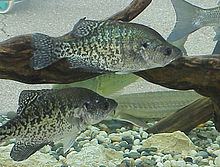User:Jwestfie/sandbox
| White crappie | |
|---|---|

| |
| Scientific classification | |
| Kingdom: | |
| Phylum: | |
| Class: | |
| Order: | |
| Family: | |
| Genus: | |
| Species: | P. annularis
|
| Binomial name | |
| Pomoxis annularis Rafinesque, 1818
| |
The white crappie (Pomoxis annularis: Promoxis=opercle sharp; annularis=having rings) is a freshwater fish found in North America, one of the two crappies. [2]Former common names include goldring and silver perch.[3] The USS Goldring is named for the fish.
Description[edit]
White crappies are morphologically similar to black crappies. They have 5–10 dark vertical bars along their body, rather than the randomly scattered spots like the black crappie. The white crappie has a silvery color with green or brown shades along its back, with dark lateral bars along its side and a white belly. The dorsal fin of the white crappie starts further back on the body than that of the black crappie. The anal fin is approximately the same size as the dorsal fin.[4] The white crappie has 6 dorsal fin spines, whereas the black crappie has 7-8 dorsal fin spines[5]. White crappies are also slightly more elongated than black crappie.[6] The species is a deep-bodied fish with a flattened body, or a depth that is one-third of the length of the fish. White crappies have spinous rays and ctenoid scales, Fish Scales found in advanced teleosts. The exposed part of the scale has tiny tooth like projections (cteni). Both species of crappie have a terminal mouth position with many small conical teeth. The teeth occur in two rows along the mouth and are called cardiform, because they resemble a tool used for wool carding. White crappie belong to the Infraclass Teleostei, which is one of three infraclasses in the class Actinopterygii.[7]
The white crappie rarely exceeds two pounds, and lives around 2–7 years. White crappies are generally 9-10 inches in length. [8]The current for all-tackle fishing world record for a white crappie is 2.35 kilograms (5.2 lb).[9]
Geographic Range[edit]
White crappies are native to the Great Lakes, Hudson Bay, and the Mississippi River basins expanding from New York and southern Ontario westward to South Dakota and down southward all the way to Texas. This species has a large geographic range in the United States and currently has a stable population. Currently, this species is listed as a least concern for requiring conservation efforts. [10]

Habitat[edit]
White crappies can be found in large rivers, reservoirs and lakes. White crappies are more tolerant of turbid (murky) waters than black crappie. The white crappie usually outnumbers the black crappie in turbid waters and in areas with little rooted aquatic vegetation[11] White crappie are most commonly found in rivers and low-velocity areas such as pools and backwaters of rivers. They are most abundant in lakes and reservoirs that are larger than 5 acres.[12]The white crappie can be found in the open water during the mornings and evenings, but during the day this species will be found in shallower quiet waters (6-12 feet) surrounded by structure. [10]
Reproduction[edit]
White crappie spawn in May and June. Spawning occurs when the water temperature reaches 56 degrees Fahrenheit. Males construct nests by creating small bowl-shaped depressions on the bottom around brush, rocks, and logs in the shallow water. During the spawning season, males develop dark coloration on their throats. Females lay 5,000 to 30,000 eggs.The males guard these nests until the fry swim away.[6] Males guard these nests because it helps ensure the success of their genes being passed on to the next generation. The white crappie typically grows 3-5 inches within the first year of its life and can grow an additional 3-4 inches in the second year. The white crappie reaches maturity around their second or third year.[2]
Diet[edit]
The white crappie is neither a cruise nor ambush feeding strategist. Instead, white crappies swim intermittently and only search for prey when stationary. This type of feeding strategy is considered to be a saltatory search strategy or pause and travel search. Using this type strategy, juveniles can grow rapidly in the first few days of life. This strategy is energetically favored to reduce search time for the species. When the white crappie is in the larvae and juvenile stages of life, the fish are zooplanktivorous.Young crappies feed primarily on small invertebrates during their first year of life.[6] [13][14]
When the species reaches a length of 12-15 cm, the crappie is considered an adult where it then feeds mainly on other fish and some large invertebrates such as crayfish and hellgrammites.[12][15] The terminal mouth position, sometimes known as the normal position, allows for this species to feed on what is in front of it. Generally, freshwater fish species with a terminal mouth position can be found in the middle of lakes.
References[edit]
- ^ IUCN Red List of Threatened Species. 4.1.
{{cite journal}}:|access-date=requires|url=(help); Missing or empty|title=(help); Unknown parameter|assessment_year=ignored (help); Unknown parameter|assessor=ignored (help); Unknown parameter|criteria-version=ignored (help); Unknown parameter|taxon=ignored (help) - ^ a b http://tpwd.texas.gov/huntwild/wild/species/wcp/
- ^ http://www.scwildlife.com/pubs/marapril2010/crappie.html
- ^ nature
- ^ https://nature.mdc.mo.gov/discover-nature/field-guide/white-crappie
- ^ a b c http://www.iowadnr.gov/Fishing/IowaFishSpecies/FishDetails.aspx?SpeciesCode=WHC
- ^ Jon Grinnell, Flowyd Downs Vertebrate Zoology Biology 242 Laboratory Instructions, Gustavus Adolphus College,
- ^ https://nature.mdc.mo.gov/discover-nature/field-guide/white-crappie
- ^ IGFA World Record:White Crappie - (Pomoxis annularis)
- ^ a b http://www.iucnredlist.org/details/202602/0
- ^ http://www.dnr.state.oh.us/Home/species_a_to_z/SpeciesGuideIndex/whitecrappie/tabid/6788/Default.aspx
- ^ a b http://pages.ripco.net/~jwn/crappie.html
- ^ https://www.researchgate.net/profile/Barbara_Evans2/publication/237182487_A_New_View_of_the_Predation_Cycle_of_a_Planktivorous_Fish_White_Crappie_Pomoxis_annularis/links/0f317530f878ba2799000000/A-New-View-of-the-Predation-Cycle-of-a-Planktivorous-Fish-White-Crappie-Pomoxis-annularis.pdf
- ^ http://fishlarvae.org/common/SiteMedia/Browman_OBrien_1992_Env_Biol_Fish.pdf
- ^ http://www.fishingtipsdepot.com/crappie-fishing-tips.php
- Froese, Rainer; Pauly, Daniel (eds.) (2006). "Pomoxis annularis" in FishBase. March 2006 version.
- "Comprehensive Report Species - Pomoxis annularis". NatureServe Explorer. Retrieved 2006-06-29.
External links[edit]
 Media related to Pomoxis annularis at Wikimedia Commons
Media related to Pomoxis annularis at Wikimedia Commons

